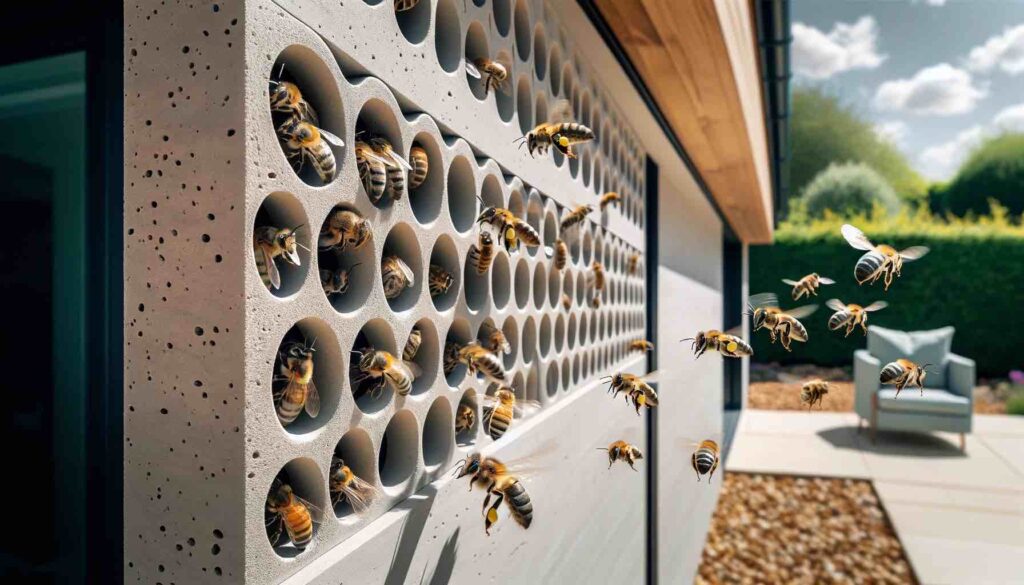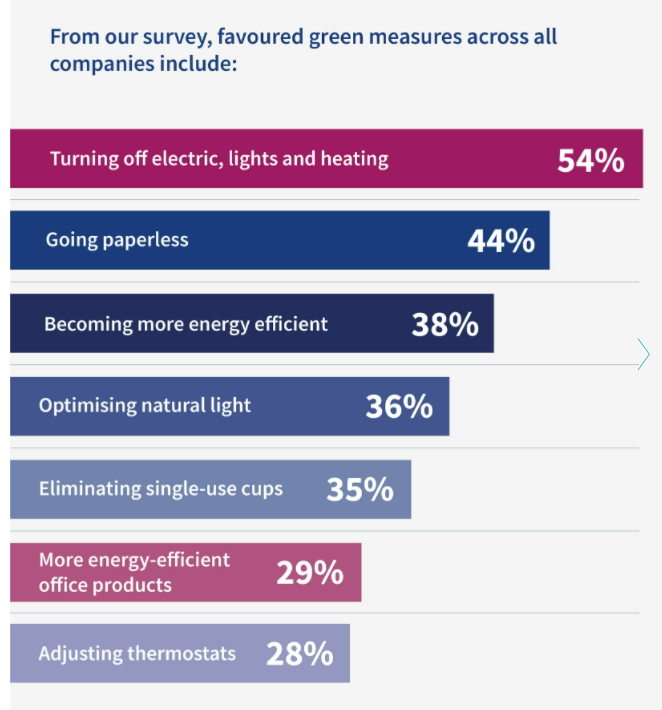Over thirteen yearsexperience in the industry
We can offer aMarket comparison
Accepted bymajority of high street banks
Recognised byUK Finance
Hayfield Homes Leading the Way in New Build Net Zero Developments
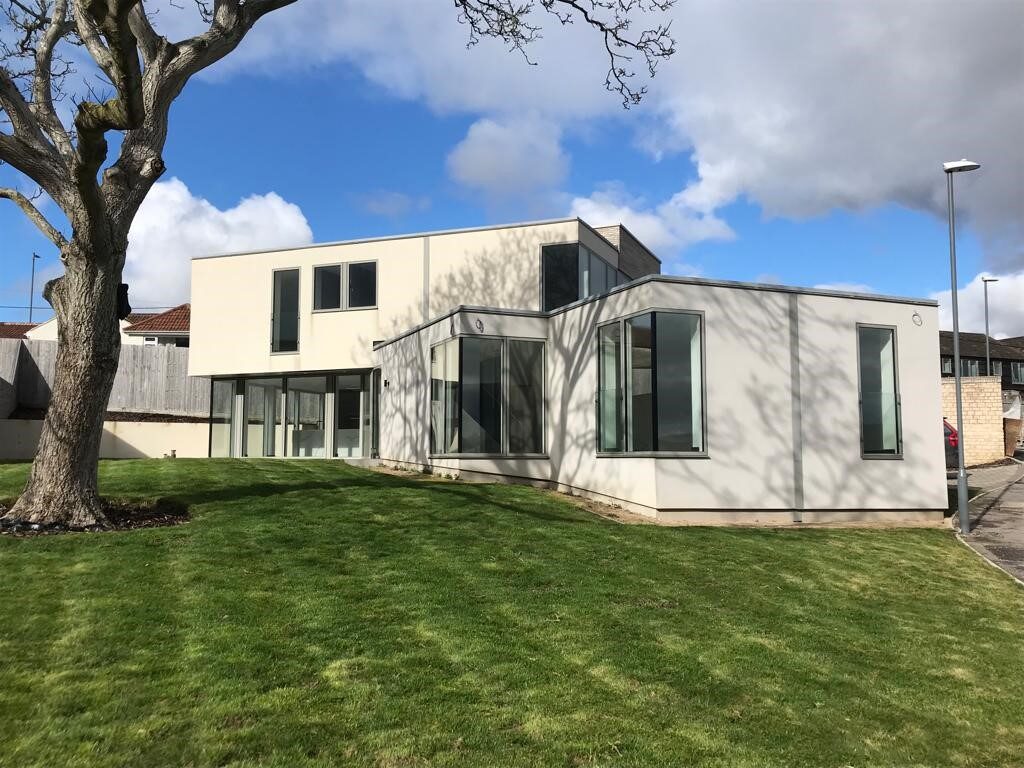
Midlands based housebuilder Hayfield Homes are leading the way in eco home building at their latest development just outside Worcester.
All homes will be built with an air source heat pump – therefore no connection to the grid is required.
The heat pumps, located externally, operate continually to drag heat from the ground and outside air into the heating system inside the homes creating little noise as they are based on acoustic feet.
The size of pump is determined by the size of house from 9kw for a 5 bed detached down to 4kw for a 2 bed.
The larger houses are also equipped with underfloor heating to maximise the efficiency of the heat pumps. 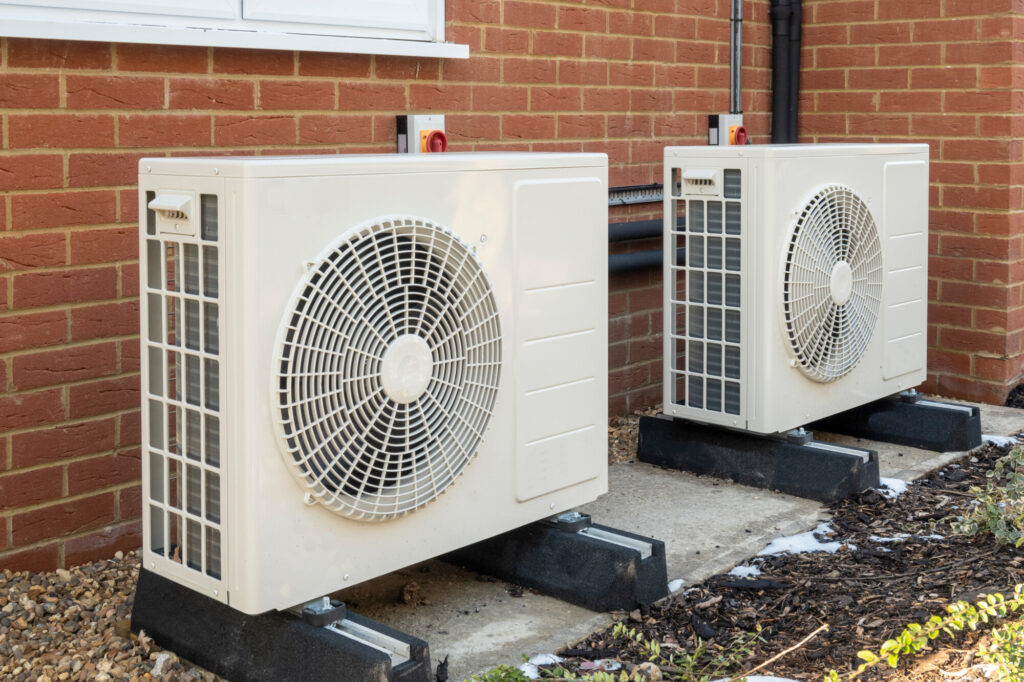
Hayfield Homes started fitting air source heat pumps in their new builds back in 2019 to get ahead of the curve before the Government’s new building standards come into force in 2025 pushing fossil fuels out of all new build homes.
The use of air source heat pumps is essential if the Government is to reach its net zero target by 2050.
There is one challenge with this move to cleaner energy, that is the demand on the electricity grid and Hayfield have had to create new electricity substations to meet the demands of its new homes.
When used correctly, it is proven the efficiency and cost effectiveness of air source can be very significant.
For further information please contact Ed, Kelly & Issy on Tel: 01284 365345 or email ed@granitebw.co.uk / kelly@granitebw.co.uk / issy@granitebw.co.uk
Biodiversity, the Birds & the Bees…
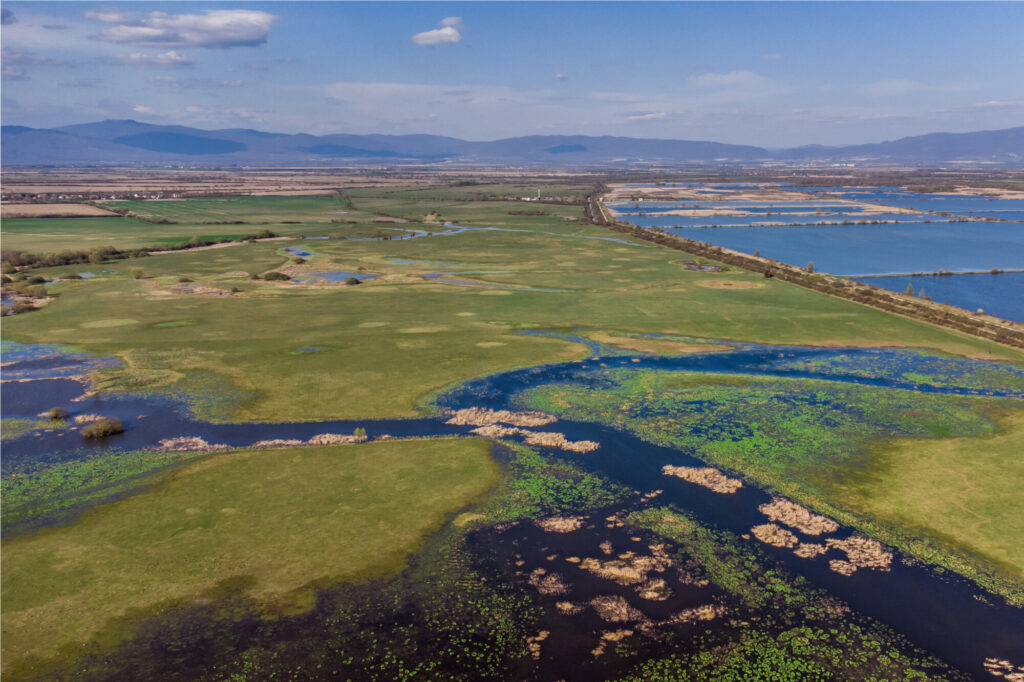 According to the Wildlife Trust, the UK has lost 97% of Lowland meadows since 1930 (1), with the government’s target of 300,000 homes a year, the UK will continue to see this percentage climb. As crucial as it is to meet this target for new homes, we must preserve our Nature and Wildlife.
According to the Wildlife Trust, the UK has lost 97% of Lowland meadows since 1930 (1), with the government’s target of 300,000 homes a year, the UK will continue to see this percentage climb. As crucial as it is to meet this target for new homes, we must preserve our Nature and Wildlife.
Developers, when building new homes, are obliged to minimise the risk to surrounding biodiversity and should provide a Protected Species survey (2), ecology report or environmental report for their planning application.
It’s important Planners and Developers understand different species, the types of environments these species live in and how we can mitigate damage to their habitats, with relevant developments including New Builds, Conversions, Demolition, Extensions and Roofing Work.
Examples of Protected species in the UK:

- Bats – Commonly found in derelict buildings, Traditional Barns/Oast houses.
- Badgers – Found in Suburban Meadows or Grasslands.
- Otters – Found in Costal Habitats.
- Dormice – Found in Woodland, Scrub or Hedgerows.
- Reptiles – Found in Woodland, Scrub or Hedgerows.
- Newts – Found in Woodland, Lowlands or slow flowing water bodies.
- Water voles – Found in Ponds or slow flowing water bodies.
- Barn Owls – Found in Traditional Timber frame buildings.
What can developers do to help?
- Hedgehog highways – A Hedgehog Highway is a series of holes in fence panels which allow hedgehogs to move freely between gardens and parks.
- Bat Boxes – Boxes on the outside of buildings at Roof Level
- Bee Bricks – Bee bricks are regular bricks with a collection of narrow openings, where solitary bees are known to nest. Brighton & Hove Council have recently passed a policy which states that all new buildings above five meters should include bee bricks and bird nesting boxes.
- Netting Bridges – Net Bridges across roads, to keep Species such as Bats above the level of Traffic. A good example of this A11 – Barton Mills.
- Necessary removal of trees – Ensure that trees/hedges that require removal are removed outside of nesting season.
- Hedgerows/Trees – A comprehensive biodiverse landscaping plan is essential.
- Badgers – Limiting work with heavy machinery during certain times of the day. Relocating and creating new Badger Setts.
- Sustainable Drainage System – Sustainable Drainage system’s managing surface water. The idea is to mimic natural drainage and can include Green Roofs, Permeable Paving’s & ponds.
Developers when building new homes, are obliged to minimise the risk to surrounding biodiversity. They are to provide a Protected Species survey, ecology report or environmental report for their planning application.
A local example is Trumpington Meadows just outside of Cambridge, a 1,200-home development, with 58ha of greenspace (3). The interesting design has allowed for the Greenspace to be in one single block, rather than dotted throughout the development, Allowing for a beautiful nature reserve and home to many species.
- Mix of Homes: Trumpington Meadows provides a wide mix of new homes to meet local housing needs, with 60% for private sale (New Build Warranty) and 40% affordable. (Affordable Home Warranty)
A further example is Mace’s recent announcement to create 2000m of Shallow foot drains at Fobbing Marshes, Essex (4). This will allow water to be held closer to the surface to improve the quality of the grassland for Wetland Birds & Invertebrates.
Biodiversity Net Gain
Biodiversity Net Gain is the idea of implementing systems which ensure the impacts of a development are overall positive and aims to leave the natural environment in a measurably better state than it was before, requiring a 10% minimum net gain for biodiversity, through enhancement or habitat replacement on or near a new development site.
Through the environment Act 2021, this will become mandatory from November 2023, which will enable developers to commit to Climate Change.
References
THE IMPORTANCE OF SUSTAINABLE BUILDING METHODS

As we work towards the Government’s target of Net Zero by 2030 the importance of building sustainable new homes is ever more important.
A recent study by CBRE looking at the cost effectiveness of new homes, showed that modern building methods are more energy efficient than their older counterparts and that new homes built sustainably are future proofed against the new upcoming legislation on the road towards Net Zero.
Home owners are becoming a lot more conscious of their homes “Green Credentials” and are now looking carefully at the energy performance of their homes and how that can help reduce the energy bills as prices continue to rise.
Landlords too will have to ensure their properties meet the energy efficiency standards of the new builds from 2025.
Sustainable new developments are being built by developers such as Human Nature who are looking to reimagine “a more optimistic vision of what it is to live well in the 21st century” according to chief executive Jonathan Smales. Our developments aim to be the lowest carbon and most sustainable developments in the UK, using sustainable engineered timber, powered by 100% renewal electricity and heated by ground and water source heat pumps.
We have the technology to build sustainably and the government is now looking to industry to help inform upcoming consultations on 2025 Future Homes Standard.
For further information please contact Ed, Kelly & Issy on tel: 01284 365345 or email: ed@granitebw.co.uk / kelly@granitebw.co.uk / issy@granitebw.co.uk
REDUCE, REUSE and RECYCLE – Waste Management in the Construction Industry
Over 50,000 new construction sites started between 1st April and 30th June 2022 alone, it’s not a surprise the construction industry uses approximately 400 million tonnes of building materials a year. It is estimated that, on average, 25% (100 million tonnes) go to waste each year and 93% is recycled and reused.
The majority of waste goes to landfill, where hazardous materials need to be managed correctly otherwise, they could cause soil and water pollution. Therefore, it is crucial that construction companies aim to Reduce, Reuse, and Recycle to minimise their waste and conserve the planet.
How can we Reduce, Reuse and Recycle?
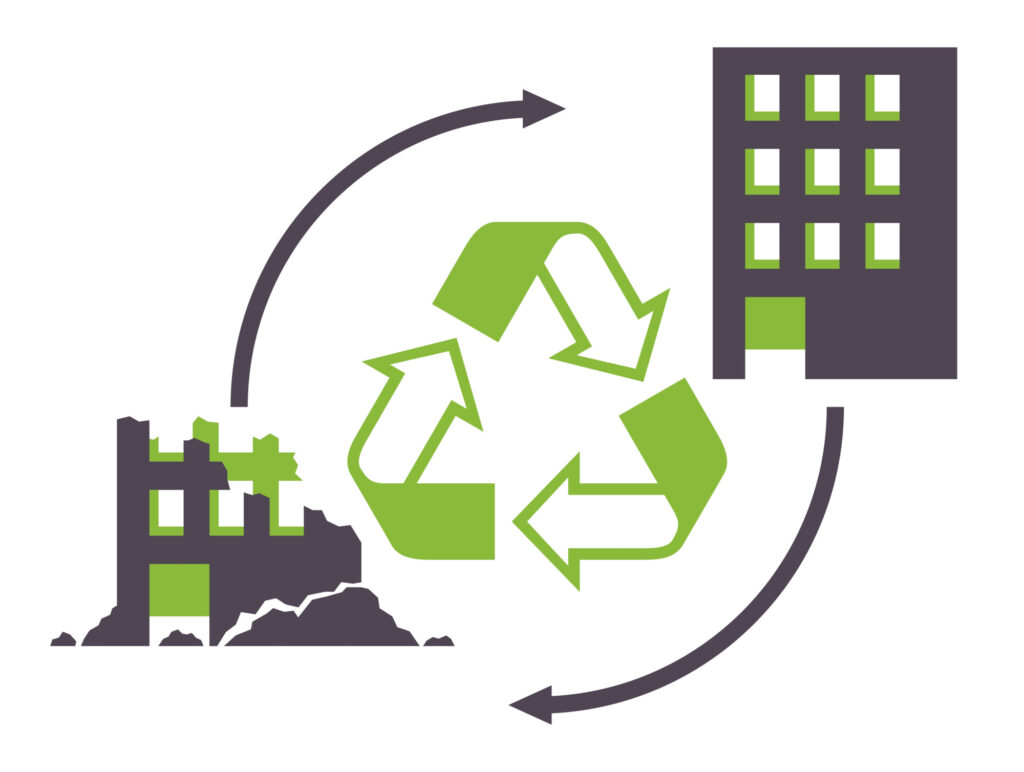
Reduce
- Avoid over ordering
- Avoid ordering errors
- Reduce offcuts
- Don’t remove plastic until the material will be used
- Order materials to match your specification
Reuse
Do not waste any surplus items, store, and reuse:
- Bricks and tiles
- Concrete blocks
- Timber
- Plasterboard
- Packaging
- Sanitary wear
- Plastic
Recycle
It is essential to recycle to reduce the amount that ends up in landfill. Common materials you can recycle are:
- Wood
- Plasterboard
- Metal
- Crushed concrete
- Cardboard and paper
- Certain plastics
- Crushed glass
What are the Benefits of Recycling?
Cost-Saving Opportunities
- Recycling can save you disposal and landfill fees, as well as the purchase of new materials. On April 1st 2020, landfill tax was increased by HM Revenue and Customs to £94.14 per tonne for standard waste and £3 per tonne for lower-rated (inert) waste
Environmental Benefits
- Reducing the amount of waste to landfill reduces the strain on natural resources and also reduces the amount of hazardous substances causing further soil and water pollution
Health and Safety
- Carefully storing surplus materials and waste can minimise the risk of accidents and hazards on site
There are increasingly more options available in terms of recycling and reusing construction materials and in turn, reducing landfill waste. Despite this, a large amount of construction waste is still sent to landfills and makes up 32% of this, with 13% being products sent directly to landfill without being used.
It is, therefore, crucial that construction companies continue their aim to reduce, reuse, and recycle to minimise their waste and conserve the planet’s natural resources.
For further information please contact Ed, Kelly & Rob on Tel: 01284 365345 or email ed@granitebw.co.uk / kelly@granitebw.co.uk/ rob@granitebw.co.uk
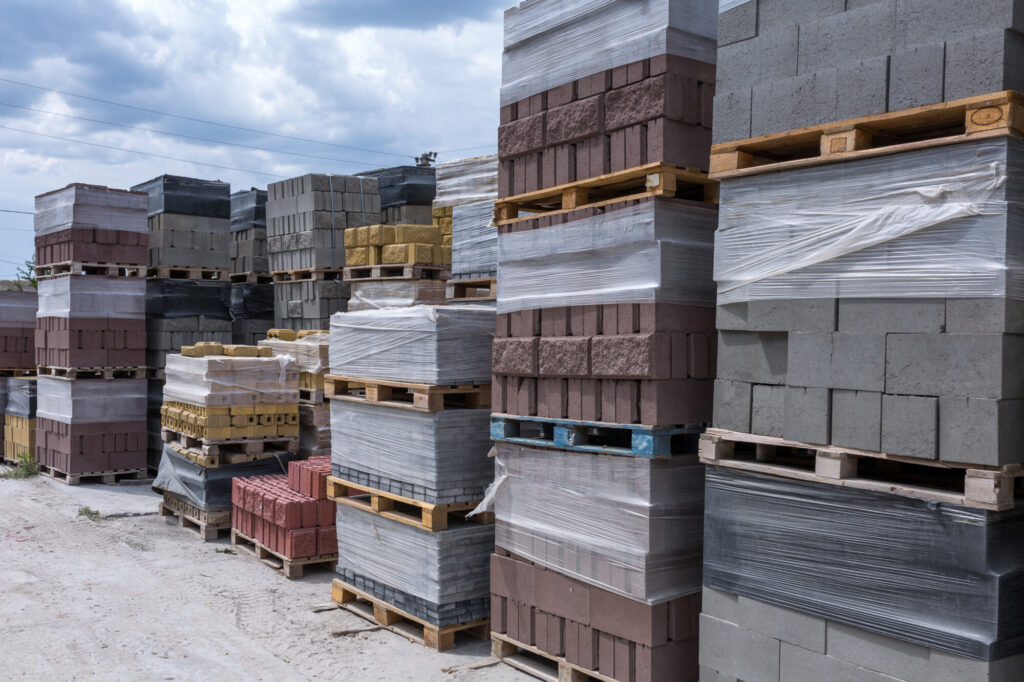
Climate Change – the Impact on Housing and Construction
With the impacts of Climate Change becoming more and more apparent, the UK construction industry is evolving to keep up to pace with the changes required to contribute toward a more sustainable industry.
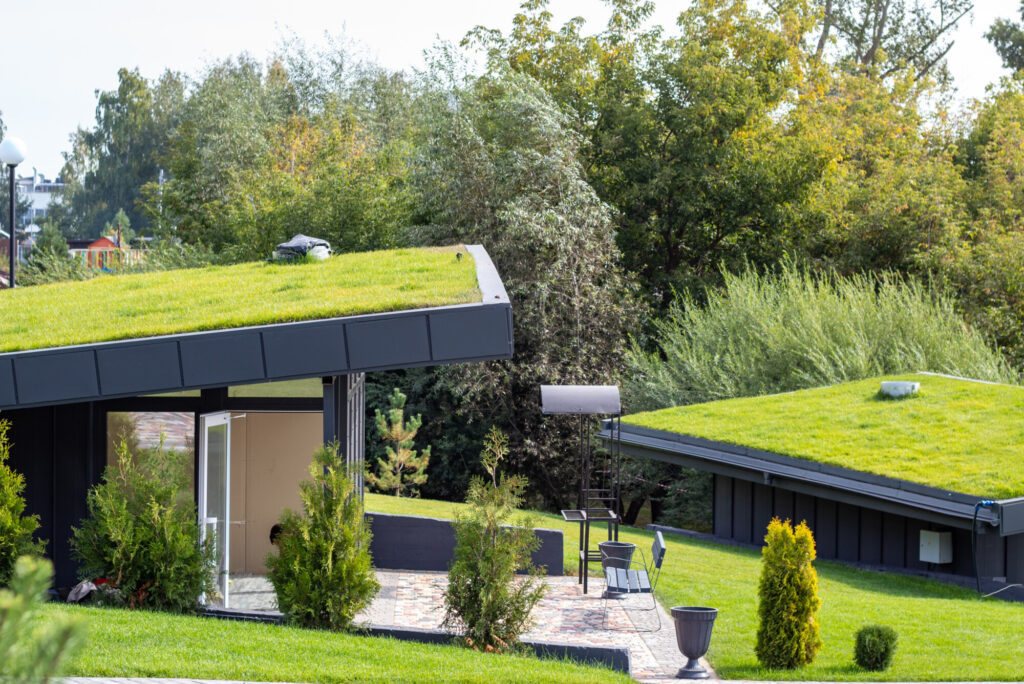 By the end of the 21st century, all areas of the UK are predicted to be warmer (1), with UK Summers seeing the greatest rise in temperatures, and the winters seeing a 30% increase in rain. Nearly 5.2 million properties are at risk of being flooded every year (2), equating to 1 in 6 properties. By 2050, this number could double.
By the end of the 21st century, all areas of the UK are predicted to be warmer (1), with UK Summers seeing the greatest rise in temperatures, and the winters seeing a 30% increase in rain. Nearly 5.2 million properties are at risk of being flooded every year (2), equating to 1 in 6 properties. By 2050, this number could double.
The built environment contributes to 25% of the UK’s total greenhouse gas emissions annually, with this in mind the UK government has started to examine the ways in which emissions can be reduced whilst still reaching the 300,000 homes target annually.
Here at Granite, we have been looking into some ways developers can ensure properties are attempting to reach the Net Zero Carbon target.
What is a Net Zero Carbon property/build?
In principle, a Zero Carbon house produces zero or negative CO2 emissions. They aim to maximise energy efficiency and maintain renewable energy. It is important to note that location plays a big part in suitability for generating and accommodating renewable energy.
Advantages
- Greater demand for energy-efficient properties (3) – with profits averaging 20% more than for an existing property
- Lower carbon footprint
- Reduction in waste
- Reduction in greenhouse gas emissions
- Savings over time
Disadvantages
- High initial cost of sustainable build/heating
- Energy Supply may differentiate depending on the weather conditions
- Funding from lenders may be difficult due to the relative newness of methods/technology
- Construction methods can be complex and specialist builders may be required
Air Source Heat Pumps
- Air source heat pumps absorb heat pumps from the outside air into a liquid refrigerant at a low temperature. By using electricity the pump compresses the liquid to release its stored heat. The Heat is then sent to your radiators or underfloor heating. This can then be stored in the hot water cylinder.
- According to Savills latest report, in 2021 the UK installed 1.48 heat pumps per 1,000 households, however, countries such as Norway installed 49.77 heat pumps per 1,000. Despite the increased cost of a Heat Pump, compared to a Gas boiler they are 300-400% more efficient per Kilowatt of Electricity. It is also possible to run your ASHP using Solar panels
- A typical ASHP costs between £7,000 to £13,000 but some families are eligible for a £5,000 grant.
Ground Source Heat Pump
Ground source heat pumps work by transferring heat from the ground outside your home to heat your radiators, underfloor heating, and hot water. Here’s how they operate:
- Heat Absorption: A mixture of water and antifreeze circulates through a loop of pipe buried in your garden or outdoor space, absorbing heat from the ground.
- Heat Transfer: The fluid passes through a heat exchanger into the heat pump, raising its temperature.
- Heat Conversion: The heat is then transferred to water for heating purposes.
- Refrigeration Process: The fluid continues its circuit back to the submerged pipework to repeat the cycle.
- Typical Costs: Basic pump from £2,000 to £15,000. Installation from £16,000 to £45,000
Passivhaus Builds
- Passivhaus houses are based on the concept of providing brilliant indoor air quality and temperature using very little energy for heating/cooling.
- They aim to maintain a constant temperature by retaining heat from the sun
- They often have triple-glazed windows, Mechanical ventilation with heat recovery system attached
- The Average cost of a Passivhaus is 5-10% more than a conventional build (4), however, due to the high standard of build, fewer repairs and replacements are required, leading to fewer callbacks for developers.
- Passivhaus tend to value 7% higher than standard builds,
Solar Panels
- The Average cost of Solar panels is around £6,500 for a 4kwp system, with the batteries for storing the electricity, costing anywhere between £1,200 to £6,000.
- An average 4kwp can save up to 675kg of Carbon emissions annually (7)
- The Payback time for Solar Panels by January 2023’s rates, will be 3.75 years.
- Solar panels are considered ‘Permitted developments’ and often do not require planning permission.
- The Average system will require 25m2 of roof
Bamboo
- Bamboo is a very sustainable alternative to Timber, and researchers argue stronger than Steel (9).
- Bamboo can grow in areas where no other plants can and grows much faster than Timber.
- Most Bamboo species can survive UK winters, with no additional care required.
- Bamboo tends to be more cost-effective than traditional materials
What is the government doing to push developers towards Net Zero Carbon?
In June 2022, the government implemented changes to the Building Regulations (5) in favour of building Net Zero Carbon properties, the changes are as follows;
- All new homes must produce 31% less carbon emissions.
- New non-domestic builds will need to produce at least 27% less carbon emissions
- New metric for measuring energy efficiency
- New minimum efficiency standards have been provided
- New and replacement heating systems in both domestic and non-domestic builds must have a maximum flow temperature of 55 Degrees.
- Existing non-domestic buildings must improve the efficiency of heating and hot water boiler systems.
- Background trickle vents have been recommended for non-domestic buildings along with a new requirement for CO2 monitors in all offices.
The Green Deal
The Green Deal (6) is a scheme set up by the UK government to enable homeowners to benefit from energy-saving improvements. Any Household within England, Scotland or Wales with an electricity meter can benefit from the scheme.
An assessment of energy usage within your home will be undertaken by a Green Deal Assessor (8) and will evaluate how you could benefit from the improvements. This could include;
- Replacing windows and doors
- Draught proofing
- Wind power or solar panels
- Insulation
- Upgrade to lighting
- Double glazing
A loan is granted by a chosen provider and is paid back through a charge added to your electricity bill. The Green Deal stays with the property so if you move you no longer make repayments. The Annual repayments on the loan shouldn’t be more than the savings you would make from benefitting from the improvements.
With this in mind, the Construction sector is becoming more aware of the need for change. It appears the Government are clearly aware of the severity of Climate Change, offering continuing support to the Construction Industry.
For further information please contact Ed, Kelly & Rob on Tel: 01284 365345 or email ed@granitebw.co.uk / kelly@granitebw.co.uk/ rob@granitebw.co.uk
References
- Met Office
- Gov
- Property Reporter
- Homebuilding
- Gov
- Green Deal Gov
- Carbon Emissions
- Green Deal Assessor
- Bamboo
Companies Reluctant to Pay a Higher Price for Greener Offices
According to a recent occupiers’ survey conducted by YouGov and Irwin Mitchell, businesses are less keen to invest money in increasing the green credentials of their offices. They are looking more to changing habits within the workplace to offset their carbon footprint.
Larger businesses are the most likely to invest in ways to reduce their environmental footprint; including paying more for a greener office space (15%), having a sustainability team (36%) and investing in Property Technology (30%). A further 29% said they would accept increased rent if there was a financial incentive to do so, such as reducing service charge or energy costs.
The smaller businesses, however, feel that adopting greener practices is costly at a time when they are looking to save money.
Changing habits seem the most popular way of reducing the environmental impact of the office. Turning off lighting, heating and electric when offices are unused is the most popular option.
It appears to be the belief that small changes from employees across the company can have a big impact on environmental issues. This is a more favoured approached than investing money into future technologies.
According to Larry Fink of Blackrock, however, ignoring the green agenda is a perilous decision that will leave behind the companies that don’t adapt: “Decarbonising of the global economy is going to create the greatest investment opportunity… accompanied by enormous job creation for those that engage in the necessary long-term planning.”
Overall, however, it would seem that green decisions are still being driven by financial considerations for the majority of companies.
For further information, please contact Ed or Kelly on 01284 365345 or email ed@granitebw.co.uk / kelly@granitebw.co.uk.
Is Slowing Wind Speed a Future Question Mark Over the Viability of Wind Turbines as a Serious Alternative to Fossil Fuel?
Renewable energy sources have long been heralded as our way out of the carbon crisis and reducing climate change. But is climate change itself impacting on the ability of wind to generate our electricity of the future?
A lull in wind speeds over Europe in 2021 has been a cause for concern. The longest calm spell in 10 years was recorded in March 2021. Coal fired power stations had to be used to combat the lack of electricity generated by the wind.
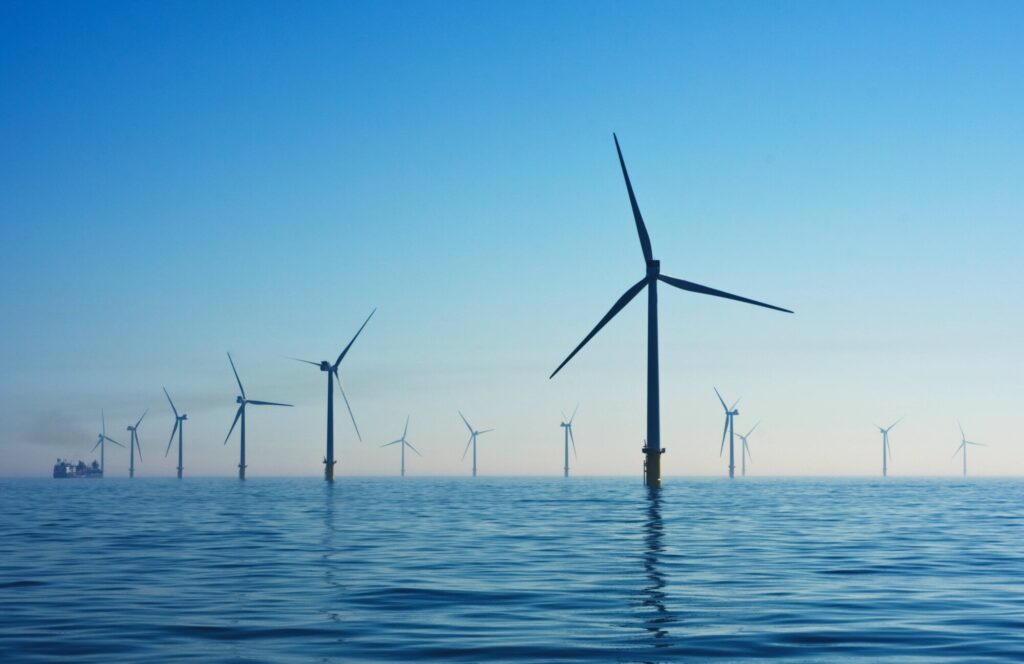
According to Paul Williams, professor of Atmospheric Science at the University of Reading, “Given what we saw in 2021, I think we will see and we need studies to understand (wind trends) better, especially given our increased reliance on wind as an energy source.” (Source: The Telegraph).
Scientists and the boardroom are equally concerned; but wind modelling is a complicated and uncertain thing to predict over the long term. Some scientists have estimated up to a 10% fall in wind speed by 2100. Other research suggests wind speeds could increase. Overall, the UK long term averages for wind speed remain close to the average.
There is also the argument that future wind turbines will be more powerful. So will easily compensate for lower wind speeds and still be able to generate more electricity.
Here in the UK we are well positioned to keep investing in wind turbines, as the North Sea remains one of the windiest areas. Even with a 10% fall in wind speed, this would not substantially affect electricity generation. The more turbines we build around Britain, the more resilient we will be to changes in wind speed.
However, with the imminent retirement of many coal and gas fired power stations in the immediate future, these changes must be addressed and investigated as the old power houses will not be there to help out in the future.
For further information, please contact Ed or Kelly on 01284 365345 or email ed@granitebw.co.uk / kelly@granitebw.co.uk.
Hydrogen – Is It the Best Option for Clean Energy?

Hydrogen – The Pros and Cons
Pros
- You can heat a home with it
- Drive your car with it
- The only bi-product of burning it is water and energy
- No heavy batteries needed so it can be used in trucks and buses
- No lengthy charging time and distance issues for vehicles
- If powered by green energy the process is zero carbon
Cons
- Expensive to produce cleanly via electrolysis
- Lack of infrastructure – manufacturers, pipelines, and producers
- Lacks Government legislation and investment in the UK
Conclusion
Compared to other countries, Britain is lagging behind in the hydrogen revolution. Germany has invested heavily and has 200 operational filling stations for hydrogen powered cars – Britain has only a handful.
Car manufacturers are leading the way, with several successfully launching hydrogen powered cars which are driving around. Vehicles currently form the most advanced part of the hydrogen energy revolution.
However, with the global need for reducing carbon, it is likely that the positive potential of hydrogen will have a powerful role to play in the future of clean, green energy.
For further information, please contact Ed or Kelly on 01284 365345 or email ed@granitebw.co.uk / kelly@granitebw.co.uk.
A Greener Way to Heat Your Home
With the ever increasing need to reduce the use of fossil fuels and carbon footprints, the Government is keen to promote renewable technology in our homes. The arrival of the Future Homes Standard (2), together with a decision that no new homes built after 2025 (Now 2035) will have fossil fuel heating systems, has increased the popularity of air and ground source heat pumps. Many new homes are now being built with either air or ground source heat pumps to provide the heating and hot water in the home.
Air Source Heat Pump
An air source heat pump takes cooler air from outside and boosts its temperature using a compressor. It then transfers the heat to the heating system in your home via either an air-to-air or air-to-water system. Air-to-water is most suitable when using underfloor heating and large radiators. Air-to-air uses a warm air system to heat the home. Although it cannot heat water, it will also work as an air conditioning unit in the summer.
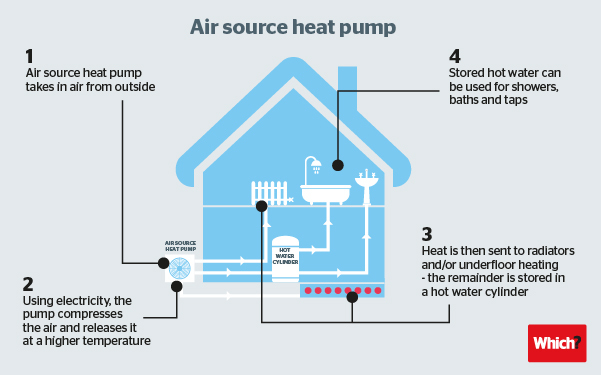
Image Source: which.co.uk
Costs ASHP
The cost of installing an air source heat pump in the UK can vary based on different factors. Here are some typical costs involved:
- According to the Energy Saving Trust, the average cost of installing an air source heat pump in the UK ranges from £7,000 to £13,000
- The price of an air source heat pump can vary between £3,500 and £8,900 depending on factors like unit power, brand, government grants, and installation costs
- A high-quality air source heat pump system can cost from £8,000, with installation for a 250m2 property costing roughly an additional £6,000
- The total price of purchasing and installing a heat pump is usually around £14,000, with the potential to access government grants like the Boiler Upgrade Scheme to reduce costs
- The supply cost of an air source heat pump ranges from £2,400 to £12,350 depending on the type of system and installation complexity
These costs can vary based on the size of the property, specific requirements, and available grants or incentives
Ground Source Heat Pump
These work by harnessing the natural warmth underground and passing water pipes through it to absorb the heat. The heat pump increases the temperature and then uses it to pump heat around the home and to heat hot water. Only ground source heat pumps are eligible for the Government’s Renewable Heat Incentive.
Both systems use electricity. Because the temperature reached is not as high as with fossil fuels, the system must run longer in order to maintain a comfortable temperature.
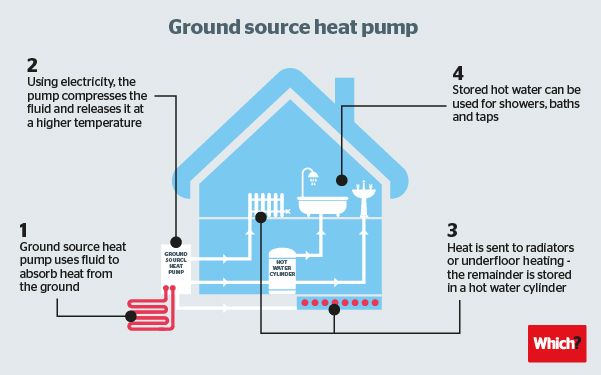
Image Source: which.co.uk
GSHP Costs
The cost of installing a ground source heat pump in the UK varies based on factors like system type and size. Here are the typical costs:
- A basic ground source heat pump can range from £2,000 to £15,000, depending on size and brand
- The average cost for a ground source heat pump installation in the UK is between £16,200 to £49,000, including additional digging costs
- A 6-8 kW horizontal ground source heat pump system typically costs around £12,000 to £15,500 to install, while a larger 12kW system would be around £24,000
- Vertical ground source heat pumps are more expensive due to borehole drilling, with a 12kW system costing around £36,000
Pros and Cons of Ground & Air Pumps
Both systems are expensive to install, costing upwards of £9,000; and good insulation is a must if they are to be efficient. Air source heat pumps will need a large outdoor unit so space outside is necessary. These can be both noisy and cold in the immediate vicinity. Planning permission will also be required in listed buildings and conservation areas. However, on the plus side, they generate less CO2 than conventional systems. Some money is available via Government grants (1) to offset the initial costs. They are most economical when used in conjunction with renewable energy providers such as solar panels, using the energy generated to run the pumps.
With the change in attitude of the home buyer, the house builders see the advantages of building with these new technologies as an asset to the home. And, fitting systems during building is much less disruptive and more efficient than replacing an old system.
It would seem this must be the way forward for us all.
For further information, please contact Ed or Kelly on 01284 365345 or email ed@granitebw.co.uk / kelly@granitebw.co.uk.
References
Copyright © 2024 Granite Building Warranties
Supported by Fox 360 Ltd
Granite Building Warranties Ltd is an Appointed Representative of Richdale Brokers & Financial Services Ltd which is authorised and regulated by the Financial Conduct Authority.
Granite Building Warranties is a company registered in England and Wales (Company Number 11497543) with its registered office at 1st Floor, 5 Century Court, Tolpits Lane, Watford, WD18 9PX
